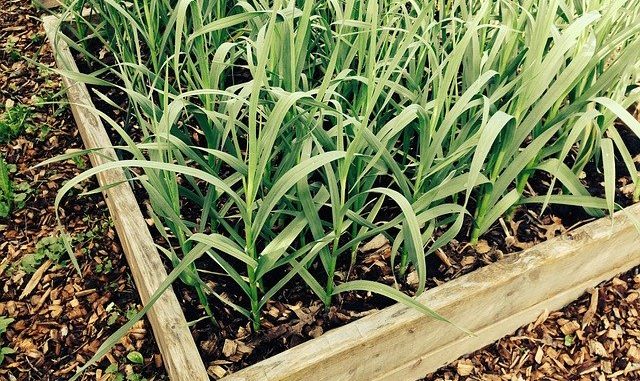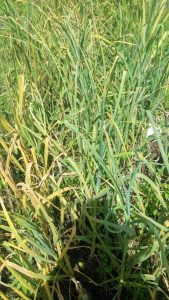
There is an unpleasant orange look to all the garlic leaves at the moment and it is not a happy moment for me trying to grow my annual supply of garlic. Simply put, rust has attacked my garlic. This particular disease is one of 7,100 different rusts which affect plants across the spectrum but the one I’m most interested in s that which affects alliums and in particular garlic, onions and leeks. Its scientific Latin name is Puccinia porri (syn. allii).
There is not a lot that an amateur gardener can do about it save for taking precautions next year in managing the next crop. I pride myself on the number of garlic bulbs produced but there are years when this particular disease takes hold and severely reduces the quality of the crop. Frankly, the inevitable will happen and the plants will be lifted and whatever has been produced just salvaged as best as possible!
Growth Of The Rust Fungus
A typical rust fungus has in many respects an uncomplicated life cycle compared to other fungal types. A fungal spore will alight on the surface of the allium leaf and infect the alveolar tissue. The fungus develops and appears to the eye mainly as pale yellow or white spots or freckles on the foliage and they just get larger as time progresses. Eventually the spots turn orange forming what is termed a late phase uredinia which are between 1 and 3 mm long and then develop into black lesions known as telia. The orange pustule is the characteristic feature of the disease and lends itself to the common name of rust. Heavy infestation simply reduces plant vigour to a point where the plant stops growing. The plant itself dies down. The bulbs generally do not form well and are left stunted. The cloves are of course perfectly edible and the flavour is not affected. Allium rust I’ve noticed in Gloucestershire starts in earnest around mid-June to complete its lifecycle.
Commercially, rust is devastating to crops because it spoils plant growth and the developing cloves. Some reports around the globe describe losses of up to 50% with economic losses of 27% as happened to the California crop in 1998. Subsequent years saw similar losses (Koike et al., 2001). For a state that produces nearly 85% of the US crop, there must have been a serious shortage of pesto and Buffy must have been wondering how she was going to tackle all those vampires.
It is particularly damaging to onions in particular which have enjoyed lush growth because of particularly high nitrogen levels in the soils. It is best to grow these vegetables in weakly fertilised soils so the next bed will not be manured as usual. I’ve also increased the level of potassium in the feed so that plant strength and general hardiness and vigour are raised. It makes them more capable of surviving harsher weather too. Potassium sulphate is the mineral of choice and is added around February or March and with care must be hoed in. One final change is to grow any cloves the correct distance apart.

One other feature which sees rust take hold is particularly hot and humid conditions and in this respect , Summer 2017 will be right up there. Interestingly, the onions have not been affected and they grow next to them.
Allium Rust can appear almost overnight but it takes about a week to a month to take hold. It is a fungus and relies on developing spores which are then released from orange pustules which cover the leaves. This distribution depends on temperature and levels of humidity. Anything which prevents their movement is sought although wind naturally is the perfect carrier for spreading the condition.
All leafy material needs to be binned or burnt because the spores can harbour themselves on the detritus. The fungal spores will overwinter on any dead onion or leek material but they certainly cannot live on it. The fungus will however overwinter on other alliums such as chives which are often grown in the vicinity. It is at its most destructive when the alliums are hit by heavy rain, mist or fog so don’t overwater either. I tend to water from the sides if I can and in the morning too because that allows water to dry off in the Sun. All my garlic is grown in full sun – no shade where possible.
Fungicides
Fungicides for the commercial grower are available but are not to be used within seven days of any harvesting. Once the fungus has taken hold, the impact of any treatment is reduced. Powdered sulphur or Dithane are two classical fungicides. Sulphur preparations are applied as dusts whilst others are sprayed on with water or added to the soil around the developing bulb. Alcohol sprays can also be tried which halts growth to a certain extent but it’s generally only palliative care.
Affected Varieties
I’m interested to see which varieties are affected. Early maturing types like ‘Early Purple Wight’ should escape simply because they can be harvested in time. These mature in May from an Autumn sowing. However, my hardnecks have really been hit but not so much my softneck types. Carcassonne Wight and Provence look to be the most susceptible. It is suggested that garlic be grown as early as possible.
Harvest what is available which is usually from mid-July onwards. Rust attack usually means an earlier harvest at the beginning of July and as in previous years when I’ve been hit by it, just dry as normal but ensure as much of the orange scraps are removed.
When it comes to storage of the garlic, just peel the outer papery layer from the bulb and trim the stem to 10cm (4in). Good hygiene with washing of all tools and hands is advised after handling the garlic to minimise any further spreading.
If you want to know more growing garlic and onions then we have two excellent sections covering their cultivation.
References
Koike, S. T., Smith, R. F., Davis, R. M., Nunez, J. J., & Voss, R. E. (2001). Characterization and control of garlic rust in California. Plant Disease, 85(6), pp. 585-591


Leave a Reply